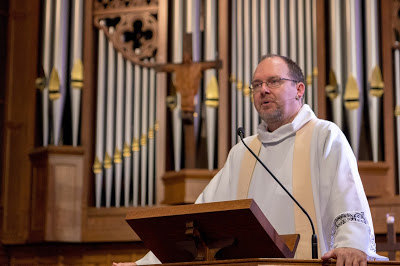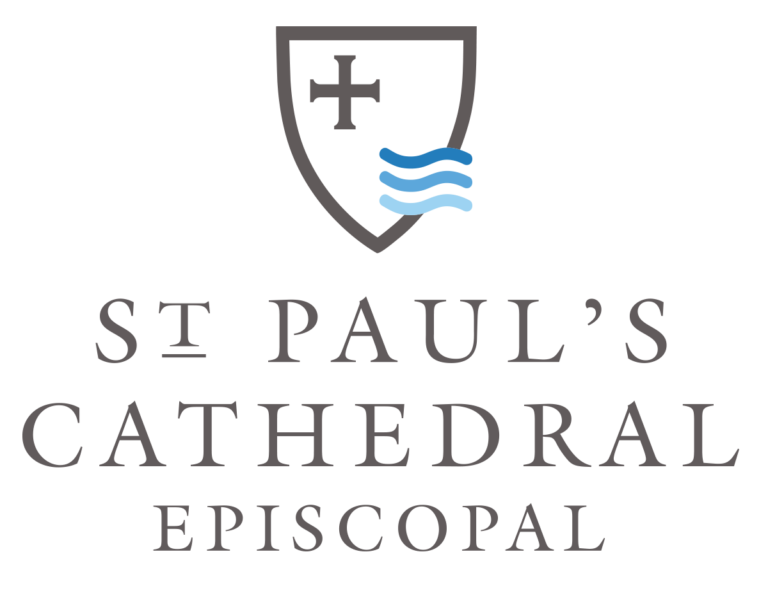
The Rev.Cn. Jeff Martinhauk
Lent 4B, March 14, 2021
St. Paul’s Cathedral, San Diego
John 3:14-21
If you are anything like me, then the gospel lesson for today immediately invokes a kind of defensive posture. John 3:16 reminds me of the kind of transactional Christianity that is often paraded at sporting events with clown wigs and signs, the kind that is designed to somehow “win people for Christ.”
If that brings people to love God and neighbor, I’m all for it. But in studying the lessons this week I think the fourth gospel is really trying for something very different than a transactional kind of Christianity. I do not think this verse is an introduction to the “believe in me and I’ll do something for you” kind of faith that has come to dominate much of American Christianity.
But I want to back up from that football verse. “Just as Moses lifted up the serpent in the wilderness, so must the Son of Man be lifted up, that whoever believes in him may have eternal life.”
I want to explore what this verse may mean in light of one of the patristic fathers of the church, St. Irenaeus.
I have always thought the “lifting up” here meant Jesus being put up on a cross. Several scholars I read this week suggested that it might also point to Jesus’ ascension. Why might that matter? St. Irenaeus is one of the first people to really explore the meaning of the ascension and explore Jesus’ humanity.
You may have seen the church meme from Irenaeus that goes around that says, “God became man so that man might become God.” Irenaeus was arguing with the gnostics in the early church about the nature and character of Jesus, mainly about his incarnation– his humanity. The bumper sticker is designed to titillate us. Irenaeus did not really think Jesus came down to become a person to make people God but rather to allow humankind to be restored to the image of God.
Incarnation is one of the things that is really important to us in Anglican theology. The gnostics in the early church insisted that our bodies and the material world were inherently bad. Irenaeus insisted that God became flesh in Jesus so that we might see the goodness of our creatureliness; that when God, at creation, who loved so much that God’s love spilled over and the creation came into being, including ourselves and our bodies, made us, called it good. We have lost sight of that goodness and become disconnected from that God. Anglicans tend to focus on that Incarnation, that divinity become flesh, because it draws us not only to the love of God but also to love of all people everywhere and of all the creation. All creation is the beloved of God and is good, and so we too are called to deeply love and care for one another.
What does this have to do with Jesus being lifted up in the ascension? For Irenaeus, the point is that God became human precisely because God loved us so much that he wanted us to remember what that image looked like. God’s love was so excessive that God’s love spilled over and the creation came to be. Because of that we bear the image of God within us. But that image became veiled; shrouded, even though it is still there. God sent God’s son in flesh so that we might be restored on the path to communion with God, to have access to the goodness of our bodies, to remember what the image of God in us looks like. That image includes a yearning for communion with God and neighbor. At the ascension, Jesus’ divinity sort of broke open the pathway to communion with God so that we can continue on the path to full restored communion with God in our ongoing sanctification, our ongoing maturation in our becoming the image of the copy of God within us.
This view of Christian life from Irenaeus is very different from what I believe is implied in the football signs holding “John 3:16.” Irenaeus is not suggesting that we profess a belief in Jesus and transactionally get into heaven.
Instead, the invitation is to read “belief” as trust– trust that Jesus is the way to full communion of God, the restoration of our original purpose and our truest selves. We take eucharist (when we are not in a pandemic) to be fed with the body and blood that strengthens us and makes us in our bodies– in our whole selves– more like that image of God. That picture of full and complete communion with God and neighbor is the very definition of eternal life.
Why might that matter?
Maya, our minister for youth and families, reflected on the lesson today from the Hebrew Scriptures using some work from our former director of formation, David Tremaine. In the lesson from Numbers, the people of Israel have forgotten what matters. As a result, they are surrounded by serpents. When they repent and beg God to remove the serpents which are plaguing them, God instructs Moses to lift an image of a serpent on a pole for everyone to see and be healed. David notes that “rather than removing the source of suffering, God transforms the source of suffering into a source of healing. Thus Jesus says it will be the same with him” in the gospel.
By trusting that God offers us a way not to escape our suffering but through it, we are transformed into a closer relationship with God and neighbor. We are fully incarnate; we were born with a full range of gifts. Sometimes our gifts get distorted in this fallen world, by things like addiction, or pandemic, or disease, or violence and trauma. But the incarnation is a pathway that allows us to see our creatureliness clearly and allow it to be transformed so that we may open ourselves to be drawn into closer communion with God and neighbor.
This week I celebrated my tenth ordination anniversary as a deacon. My mentor, the Rev. Zelda Kennedy, is the reason I was ordained, and she took great trouble to make sure she could fly to my ordination and preach.
As she was helping me through my discernment process, she talked about a treasure chest within each of us. Not just one treasure chest, but a treasure chest within another chest within another chest. We open some of these outer chests and show some of the gifts of ourselves to others in our daily lives. But the innermost chest requires a lot of prayer and discernment to access.
The gift of the ascension and of the incarnation, and the point of the Christian journey, is communion with God: having the trust to open each of those chests, knowing that within ourselves, in that innermost chest especially, we find gifts that bear the very image of God, should we dare to open the lid. It can be terrifying to open the lid on these innermost holders of our truest selves, the bearers of God’s imprint of who we were made to be. We bear more power to love than we realize, and that can be overwhelming.
As we journey through this Lent, we have the opportunity to reflect on what keeps us from opening. What might we offer for transformation so that we can become more like the image of God that we already bear? What keeps you from trusting in the one who came to show us that we are loved more deeply than we can ever imagine?
God dwells in you. Trust in your most beloved self, and listen for the voice of the Almighty.
Sources Consulted:
Farrow, Douglas B. “The Doctrine of the Ascension in Irenaeus and Origen.” ARC: The Journal of the Faculty of Religious Studies. McGill: 26, 1998, 31-50.
Sermon Brainwave, Podcast. https://youtu.be/FcVfeYM-QVg

